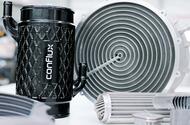3D-printed intercoolers will feature on the Dutch car maker's forthcoming P24 RS supercar
3D-printing technology – or, to use its proper name, additive manufacturing (AM) – has progressed fast over the past five years.
Dutch car company Donkervoort is one of the latest to take advantage of its unique benefits, by 3D-printing intercoolers for its forthcoming P24 RS supercar. These were developed by Australia’s Conflux, and the technique goes one step further than merely being a convenient way to manufacture things. By using AM, the weight of the aluminium-alloy liquid-to-air intercoolers has been slashed from 16kg to 1.4kg.
Conflux describes the technique as Formula 1 technology (its founder has a background in the sport), and it has other benefits too: this intercooler has superior thermal performance and packaging benefits to conventional equivalents.
It should be tougher too, because it’s a single, one-piece structure with no joints or welds. Donkervoort issued a specification for the intercooler and Conflux actually improved on it, returning a design that was so effective that it could be downsized still further from the original prototype.
Rather than mounted at the front of the car, the compact intercoolers can be sited within the engine bay, reducing the length of the inlet tract by two-thirds. The result is quicker throttle response, better efficiency and optimised weight distribution, all of which directly benefit the driver.
Coolant flowing through the intercooler is dedicated to the job and cooled by an external radiator not shared with any other drivetrain cooling system. AM is a process whereby, controlled by a 3D computer model, objects are formed by firing lasers into a bed of powdered material, fusing it together.
Conflux makes the new intercoolers from AlSi10Mg, a high-grade aluminium alloy that it claims is one of the most common and well accepted aluminium alloys in the industry. Conflux also uses it for components in aviation, motorsport and industrial applications.
Intercoolers are needed because when air is compressed (by a turbocharger in this case), it heats up and becomes less dense. For maximum performance and trouble-free combustion, an engine needs cool induction air. An intercooler cools down the compressed and heated air before it enters the engine by conducting heat through finned walls into a coolant.
Thanks to the AM process, these fins in the new Conflux intercooler are extremely thin: at 160 microns, just two or three times thicker than a human hair. And the thinner the fins can be, the more effective they will be at conducting away the unwanted heat.
More than that, Conflux uses the advantages of AM to produce sophisticated surface contours, or ‘geometries’, that take into account the changing thermal properties of the fluids as they pass through the intercooler. That adds up to more efficient heat transfer and, put simply, an intercooler that does a better job.

